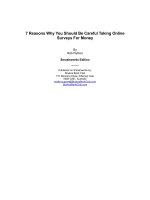After reading this chapter, you should be able to answer the following questions: What are generally accepted accounting principle? What kind of information is reported on each financial
Bạn đang xem bản rút gọn của tài liệu. Xem và tải ngay bản đầy đủ của tài liệu tại đây (2.71 MB, 23 trang )
CHAPTER 3
FUNDAMENTAL
INTERPRETATIONS
MADE FROM
FINANCIAL
STATEMENT DATA
McGrawHill/Irwin
©The McGrawHill Companies, Inc., 2002
Learning Objectives
1.
2.
3.
4.
Why are financial statement ratios
important?
How is return on investment
calculated and why is it important?
What is the DuPont model and
what do margin and turnover
mean?
What is the significance of return on
equity and how is it calculated?
McGrawHill/Irwin
©The McGrawHill Companies, Inc., 2002
Learning Objectives
5.
6.
7.
What does liquidity mean and why
is it important?
How are working capital, current
ratio, and acid-test ratio calculated
and why are they significant?
How can trend analysis be used
most effectively?
McGrawHill/Irwin
©The McGrawHill Companies, Inc., 2002
Learning Objective 1
ã
McGrawưHill/Irwin
Why are financial statement
ratios important?
âTheMcGrawưHillCompanies,Inc.,2002
Financial Ratios and Trend
Analysis
•
•
•
•
•
A ratio is the relationship between two numbers
Ratios are useful for comparing different sized
firms
Average ratios for an industry are useful for
comparisons
A trend is comparing ratios over several time
periods
Trend analysis provides are more meaningful
comparisons
McGrawHill/Irwin
©The McGrawHill Companies, Inc., 2002
Learning Objective 2
•
How is return on investment
calculated and why is it
important?
McGrawHill/Irwin
©The McGrawHill Companies, Inc., 2002
Return on Investment
Calculations
•
Rate of return =
Amount of return / Amount of investment
•
Return on investment is a measure of
profitability
•
Derived from the interest calculation of:
Interest = Principal x Rate x Time
McGrawHill/Irwin
©The McGrawHill Companies, Inc., 2002
Return on Investment
and Risk
•
In evaluating investments, risk must also
be considered
•
Risk relates to the range of outcomes from
an activity; wider range = greater risk
ã
In general, higher risk = higher return
McGrawưHill/Irwin
âTheMcGrawưHillCompanies,Inc.,2002
Financial Statements and
Return on Investment
•
•
•
•
•
Also called Return on Assets
The amount of return = Net Income
The amount of the investment = Average Total
Assets
Describes the rate of return management was able
to earn on the assets available to use during the
year
May also be calculated as Operating Income /
Average Operating Assets
McGrawHill/Irwin
©The McGrawHill Companies, Inc., 2002
Learning Objective 3
•
What is the DuPont model and what
do margin and turnover mean?
McGrawHill/Irwin
©The McGrawHill Companies, Inc., 2002
The DuPont Model
•
An expansion of the basic return on investment
calculation
•
Return on Investment =
Net Income
Sales
x
Sales
Average Total Assets
•
Net Income / Sales = Margin
ã
Sales / Average Total Assets = Asset Turnover
McGrawưHill/Irwin
âTheMcGrawưHillCompanies,Inc.,2002
Margin and Asset Turnover
•
Margin indicates that some sales
revenues must result in net income if the
firm is to be profitable
•
Turnover indicates how efficiently the firm
is using its assets to generate revenue
McGrawHill/Irwin
©The McGrawHill Companies, Inc., 2002
Learning Objective 4
What is the significance of return on
equity and how is it calculated?
McGrawHill/Irwin
©The McGrawHill Companies, Inc., 2002
Return on Equity
•
Return on Equity is a special case
application of the rate of return concept
•
Return on Equity =
Net Income
Average Owners’ Equity
McGrawHill/Irwin
©The McGrawHill Companies, Inc., 2002
Learning Objective 5
ã
What does liquidity mean and
why is it important?
McGrawưHill/Irwin
âTheMcGrawưHillCompanies,Inc.,2002
Working Capital and Measures
of Liquidity
•
Liquidity is the firm’s ability to meet its current
obligations
•
Working capital is the excess of a firm’s
current assets over its current liabilities
– Current assets are cash and other assets
likely to be converted to cash within a year
– Current liabilities are those obligations
expected to be paid within a year
McGrawHill/Irwin
©The McGrawHill Companies, Inc., 2002
Measures of Liquidity
•
Working Capital =
Current Assets less Current Liabilities
•
Current Ratio =
Current Assets divided by Current Liabilities
•
Acid-Test Ratio =
Cash and Accounts Receivable divided by
Current Liabilities
McGrawHill/Irwin
©The McGrawHill Companies, Inc., 2002
Learning Objective 6
•
How are working capital,
current ratio, and acid-test ratio
calculated and why are they
significant?
McGrawHill/Irwin
©The McGrawHill Companies, Inc., 2002
Current Ratio
•
The trend in the current ratio is the most
useful in judging a firm’s current bill-paying
ability
•
As a general rule, a current ratio of 2.0 is
considered adequate
•
The higher the current ratio, the better –
up to a point
McGrawHill/Irwin
©The McGrawHill Companies, Inc., 2002
Acid-Test Ratio
•
Also known as the Quick Ratio
•
The Acid-Test Ratio is a more conservative
measure of liquidity since inventory is not
included in its calculation
•
As a general rule, an Acid-Test Ratio of 1.0
is considered adequate
McGrawHill/Irwin
©The McGrawHill Companies, Inc., 2002
Learning Objective 7
ã
How can trend analysis be used
most effectively?
McGrawưHill/Irwin
âTheMcGrawưHillCompanies,Inc.,2002
Trend Analysis
•
Graph return against the year, with the
years listed on the horizontal axis
•
The more compressed the graph, the
more pronounced the peaks and
valleys
ã
See following graph of margin and
turnover for Intel Corporation
McGrawưHill/Irwin
âTheMcGrawưHillCompanies,Inc.,2002
1.2
30
1.0
27
0.8
24
0.6
21
1995
1996
1997
1998
Margin
Turnover
Intel Corporation
Margin and Turnover, 1995 - 1999
1999
Years ended the last Saturday in December
McGrawHill/Irwin
©The McGrawHill Companies, Inc., 2002









